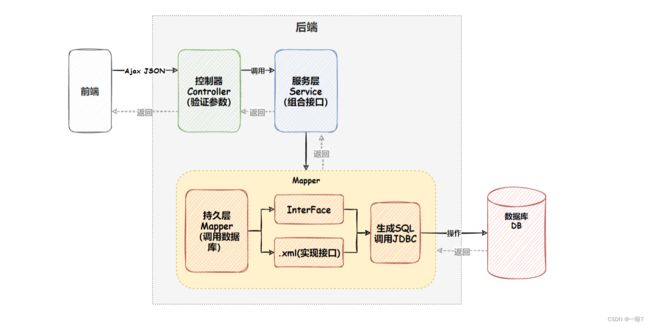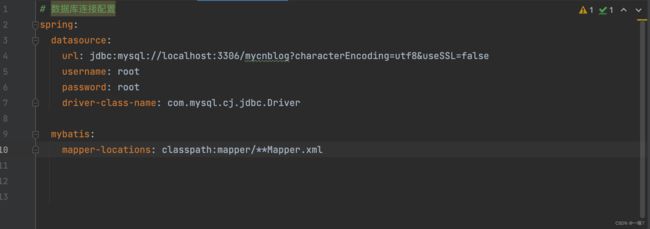MyBatis详细介绍
目录
- MyBatis详细介绍
-
- 什么是ORM
- Mybatis基本依赖配置
-
- Mybatis的依赖配置
- MySQL的依赖配置
- 配置连接字符串和MyBatis
-
- 配置连接字符串
- 配置 MyBatis 中的 XML 路径
- 举个栗子
-
- 先来建一个数据库:
- MyBatis信息配置
- 添加业务代码
-
- 添加 UserMapper.xml
- 添加实体类
- 添加 mapper 接口
- 添加 Service
- 添加 Controller
- 查询操作
-
-
- 参数占位符 #{} 和 ${}
- 注意事项
-
- 多表查询
-
- 一对一表映射
MyBatis详细介绍
MyBatis 是一款优秀的持久层框架,它支持自定义 SQL、存储过程以及高级映射。Mybatis是ORM框架,能够帮助我们完成面向对象到关系型数据库的映射, 不用写复杂的JDBC 代码以及进行设置参数和获取结果集的工作。MyBatis 可以通过简单的 XML 或注解来配置和映射原始类型、接口和 Java POJO(PlainOldJavaObjects,普通老式Java 对象)为数据库中的记录。使用Mybatis框架能否很好的提高我们开发的速度和较少不必要的复杂代码。
不过在此之前我们先来了解一下ORM
什么是ORM
Object-Relationl Mapping,它的作用是在关系型数据库和对象之间作一个映射,这样,我们在具体的操作数据库的时候,就不需要再去和复杂的SQL语句打交道,只要像平时操作对象一样操作它就可以了 。
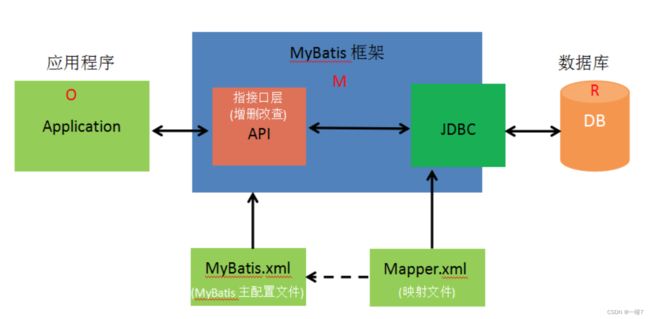
一般的 ORM 框架,会将数据库模型的每张表都映射为一个 Java 类。也就是说使用 MyBatis 可以像操作对象一样来操作数据库中的表,可以实现对象和数据库表之间的转换
Mybatis基本依赖配置
maven项目加入以来即可
Mybatis的依赖配置
<dependency>
<groupId>org.mybatis.spring.boot</groupId>
<artifactId>mybatis-spring-boot-starter</artifactId>
<version>2.1.4</version>
</dependency>
MySQL的依赖配置
<dependency>
<groupId>mysql</groupId>
<artifactId>mysql-connector-java</artifactId>
<scope>runtime</scope>
</dependency>
这是在项目开始时创建添加依赖的,难道在过程中如果想添加只能一个一个敲吗?当然不必:
介绍一个插件:
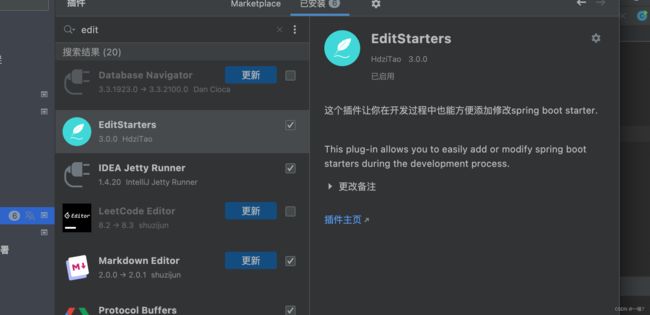
这是干啥的呢,就是在过程中添加依赖的:
在pom.xml中右击点击生成:
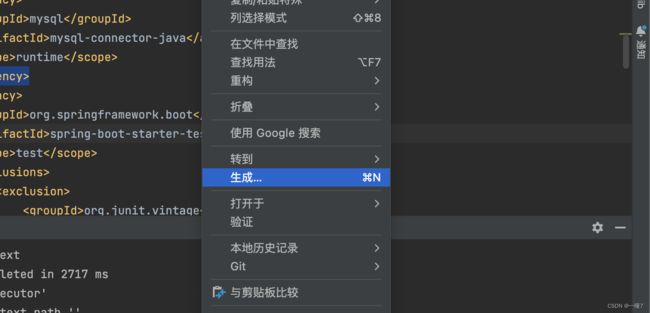
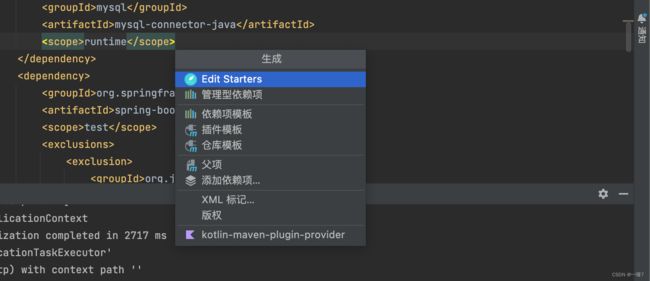
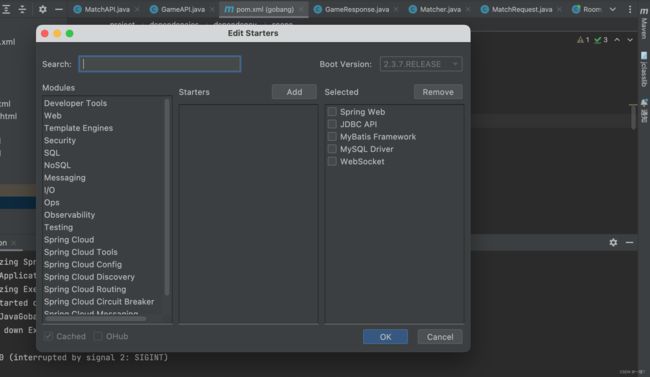
诺,到了熟悉的界面。。。。
配置连接字符串和MyBatis
配置连接字符串
datasource:
url: jdbc:mysql://127.0.0.1:3306/java_gobang?characterEncoding=utf8&useSSL=false&serverTimezone=GMT%2B8
username: root
password: wjhyd521
driver-class-name: com.mysql.cj.jdbc.Driver
配置 MyBatis 中的 XML 路径
mybatis:
mapper-locations: classpath:mapper/**Mapper.xml
举个栗子
先来建一个数据库:
-- 创建数据库
drop database if exists mycnblog;
create database mycnblog DEFAULT CHARACTER SET utf8;
-- 使用数据数据
use mycnblog;
-- 创建表[用户表]
drop table if exists userinfo; create table userinfo(
id int primary key auto_increment, username varchar(100) not null, password varchar(32) not null, photo varchar(500) default '', createtime datetime default now(), updatetime datetime default now(),
`state` int default 1
);
-- 创建文章表
drop table if exists articleinfo; create table articleinfo(
id int primary key auto_increment, title varchar(100) not null, content text not null,
createtime datetime default now(), updatetime datetime default now(), uid int not null,
rcount int not null default 1,
`state` int default 1
);
-- 创建视频表
drop table if exists videoinfo; create table videoinfo(
vid int primary key,
`title` varchar(250),
`url` varchar(1000),
createtime datetime default now(), updatetime datetime default now(),
uid int
);
-- 添加一个用户信息
INSERT INTO `mycnblog`.`userinfo` (`id`, `username`, `password`, `photo`, `createtime`, `updatetime`, `state`) VALUES
(1, 'admin', 'admin', '', '2021-12-06 17:10:48', '2021-12-06 17:10:48', 1);
-- 文章添加测试数据
insert into articleinfo(title,content,uid) values('Java','Java正文',1);
-- 添加视频
insert into videoinfo(vid,title,url,uid) values(1,'java title','http://www.baidu.com',1);
MyBatis信息配置
加下来我们根据配置配置好项目的信息:
标签:需要指定 namespace 属性,表示命名空间,值为 mapper 接口的全限定名,包括全包名.类名。
添加业务代码
添加 UserMapper.xml
<?xml version="1.0" encoding="UTF-8"?> <!DOCTYPE mapper PUBLIC "-//mybatis.org//DTD Mapper 3.0//EN"
"http://mybatis.org/dtd/mybatis-3-mapper.dtd">
<mapper namespace="com.example.demo.mapper.UserMapper">
<select id="getAll" resultType="com.example.demo.model.User">select * from userinfo</select>
</mapper>
添加实体类
package com.example.demo;
import lombok.Data;
import java.util.Date;
@Data
public class User {
private Integer id;
private String username;
private String password;
private String photo;
private Date createTime;
private Date updateTime;
}
添加 mapper 接口
package com.example.demo;
import org.apache.ibatis.annotations.Mapper;
import java.util.List;
@Mapper
public interface UserMapper {
public List<User> getAll();
}
添加 Service
package com.example.demo;
import org.springframework.stereotype.Service;
import javax.annotation.Resource;
import java.util.List;
@Service
public class UserService {
@Resource
private UserMapper userMapper;
public List<User> getAll() {
return userMapper.getAll();
}
}
添加 Controller
package com.example.demo;
import com.example.demo.UserService;
import org.springframework.web.bind.annotation.RequestMapping;
import org.springframework.web.bind.annotation.RestController;
import javax.annotation.Resource;
import java.util.List;
@RestController
@RequestMapping("/u")
public class UserController {
@Resource
private UserService userService;
@RequestMapping("/getall")
public List<User> getAll() {
return userService.getAll();
}
}
Mapper、Service、Controller?这命名有没有很熟悉?对开局给大家看的那张图来我们复习一下:
Okk,这下我们用MyBatis实现的用户查询就完成了,测试一下?
怎么测试呢?咱们又没写前端代码?嘿嘿嘿,介绍一款软件:

跟一个叫postman的软件功能基本一样,我们来测试一下如下图。

至于其他的数据库的增删改我们就不做演示了,毕竟是一样的东西。
查询操作
实现用用户id查询的操作
为啥要查询操作?因为要引出下面的一些东西:
参数占位符 #{} 和 ${}
#{}:预编译处理。
${}:字符直接替换。
预编译处理是指:MyBatis 在处理#{}时,会将 SQL 中的 #{} 替换为?号,使用PreparedStatement 的 set 方法来赋值。直接替换:是MyBatis 在处理 ${} 时,就是把 ${} 替换成变量的值。
@RequestMapping("/getuser")
public User getUserById(Integer id) {
return userService.getById(id);
}
Service:
public User getById(Integer id) {
return userMapper.getById(id);
}
UserMapper.xml:
<select id="getById" resultType="com.example.demo.model.User">
select * from userinfo where id=#{id}
</select>
UserMapper:
public User getById(int id);
注意事项
1 使用 ${sort} 可以实现排序查询,而使用 #{sort} 就不能实现排序查询了,因为当使用 #{sort} 查询时,如果传递的值为 String 则会加单引号,就会导致 sql 错误。
2 $会有sql注入问题
3 like 使用 #{} 报错,比如:
<select id="findUserByName2" resultType="com.example.demo.model.User">
select * from userinfo where username like '%#{username}%';
</select>
相当于: select * from userinfo where username like ‘%‘username’%’;
这个是不能直接使用 ${},可以考虑使用 mysql 的内置函数 concat() 来处理,实现代码如下:
<select id="findUserByName3" resultType="com.example.demo.model.User"> select * from userinfo
where username like concat('%',#{username},'%');
</select>
多表查询
这个时候就可以使用 resultMap 了,resultMap 的使用如下:

一对一表映射
<resultMap id="BaseMap" type="com.example.demo.model.ArticleInfo">
<id property="id" column="id"></id>
<result property="title" column="title"></result>
<result property="content" column="content"></result>
<result property="createtime" column="createtime"></result>
<result property="updatetime" column="updatetime"></result>
<result property="uid" column="uid"></result>
<result property="rcount" column="rcount"></result>
<result property="state" column="state"></result>
<association property="user" resultMap="com.example.demo.mapper.UserMapper.BaseMap"
columnPrefix="u_"></association>
</resultMap>
columnPrefix 如果省略,并且恰好两个表中如果有相同的字段,那么就会导致查询出错,
以上使用 标签,表示一对一的结果映射:
- property 属性:指定 ArticleInfo 中对应的属性,即用户。
- resultMap 属性:指定关联的结果集映射,将基于该映射配置来组织用户数据。
- columnPrefix 属性:绑定一对一对象时,是通过columnPrefix + association.resultMap.column 来映射结果集字段association.resultMap.column是指 标签中
- resultMap属性,对应的结果集映射中,column字段。
注意事项:column不能省略
后续闲了将详细更新动态sql
